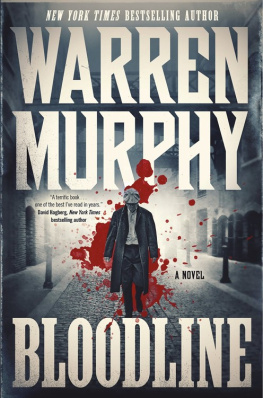Next of Kin
The Destroyer #46
by Richard Sapir & Warren Murphy
?
Copyright 1981
by Richard Sapir & Warren Murphy
All rights reserved.
Next of Kin
A Peanut Press Book
Published by
peanutpress.com, Inc.
www.peanutpress.com
ISBN: 0-7408-0569-X
First Peanut Press Edition
This edition published by
arrangement with
Boondock Books
www.boondockbooks.com
For Dave Slobodin and the House of Sinanju,
Box 1454, Secaucus, N.J. 07094.
?Prologue
It was known to the natives as Devil's Mountain. The white men on the island were unfamiliar with the name or the mountain, since the ragged lump of volcanic rock straddling the French/Dutch border of Sint Maarten did not reach even half the height of Paradise Peak or any of the other more picturesque and geologically newer mountains in the area.
But the native islanders knew. In the hushed and reverent tones reserved for telling their children the island legends that would be passed on to the next generation, the elders among the hill dwellers spoke of Devil's Mountain and its legacy of death.
It was on Devil's Mountain that the Carib Indians performed their rites of war against invading tribesmen, eating the flesh of their enemies to take their strength. A thousand years before Columbus came to claim the island for Spain, the Caribs squatted along the rim of the already long-dead volcano to toss the gleaming bones of the vanquished into its crater.
And after the Spaniards came, with their muskets and cannons, trying to wipe them off the face of the earth, the Carib Indians assembled on Devil's Mountain to decide their fate. The brave elected to fight the strange and powerful new enemy. The proud killed their wives and children so that they would not be slain by the metal-wearing invaders. But the old, the infirm, and the wise fled to the caves in the hills, where they watched their ancient race plunge toward extinction. And by night they brought the bones and bloodied bodies of their fallen tribesmen to Devil's Mountain to lie for eternity among the spirits of the dead.
In the hills these cautious few waited as the Spanish left and the English came. As the Dutch came, and the Portuguese, and the French. They waited as the island changed hands sixteen times in two hundred years, through the sugar boom and the slavery boom, which changed the island's color from white to black.
And slowly, as the island evolved into the mutual territory of the Dutch and the French, reigning over an African population, the handful of Carib Indians nurtured among the hills in the shadow of Devil's Mountain ventured one by one toward the shore and the towns where they found women among the black-skinned slaves and took them back to the hills.
Their children were strong and wise in the island ways. And after slavery was abolished from the island, they came out of hiding and married among the island's population, now grown into a race of its own with African and European blood and handsome features and strong bodies. The Caribs added their blood to the brew and mellowed it in the tropical sun and lived in peace with their new brothers for the rest of their days.
And so the fiercesome Carib Indians became extinct as a race. But they did not forget Devil's Mountain.
In the latter half of the eighteenth century, a prosperous cloth merchant from Holland sailed to Sint Maarten with a shipload of lumber and carpenters and European stonemasons to build a replica of a tenth-century castle on the mountain that stood between the French and Dutch borders. He chose the mountain because its ancient volcanic lip still protruded four feet high, making it a natural fortification, and because he didn't give a hang whether or not the French thought half the island was theirs. He was Dutch, the island was Dutch, and he would build his castle wherever he wanted. Besides, the French prefect accepted the Dutchman's gift of 1,000 guilders to leave him alone.
He found later that the bribe was unnecessary. No one wanted the mountain. Europeans would visit the Dutchman in his castle, but they could find no guides to take them there. No island cooks would come to the place, no maids to clean it. No messengers, farmers, laborers. The islanders would not touch Devil's Mountain with the soles of their shoes.
So, bitter and lonely, the Dutchman sailed back to Holland, leaving his castle to fall into neglect and decay for more than a hundred years.
Then, amazingly, the castle came alive again. The natives whispered to one another as the helicopters whirred above the plateau of Devil's Mountain and as the team of burros led by a single, silent man made its way up the slope, dragging behind it the bulky furnace that was to heat the place. They gasped in amazement as the small planes at Juliana Airport disgorged their cargoes of dozens of magnificently beautiful women bound by helicopter for Devil's Mountain. And they stared up at the castle with curiosity and dread as they discussed its new occupant. Who would live in such a place, some asked, with its crumbling walls and smell of death and sadness? Only a European, others answered, like the old Dutchman himself.
Some had seen him, walking through the village with the small, silent man who obeyed his orders and talked to him with his hands. He was extraordinarily handsome, the women said, with yellow hair and eyes of ice blue. He walked like a cat. He would be a good lover. Still, there was something odd about him, something too still. He never smiled, and when he walked into a store, where people could see him, his footsteps made no noise on the floorboards. Animals hated him. He could not come within twenty feet of a donkey or a goat without sending the beast into panic. And though he spoke many languages, he never talked except in the briefest of business exchanges. He had no friends. Not even the Europeans on the island knew him.
They called him the Dutchman.
And all feared him. And avoided Devil's Mountain.
?One
The Dutchman waited.
On a deep ledge beneath a bank of narrow archer's windows in the castle, he squatted on his haunches like a cat about to spring. He was dressed in an Oriental gi and his feet were bare on the cold stone of the ledge. In the twilight, his golden hair glinted as the island breeze brushed past his face.
Below him, on the Dutch side of the island, spread the immense Soubise Harbor Transportation Corporation with its thousands of tons of cargo packed into truck containers, awaiting the great ships that would heave into Sint Maarten Harbor. Beyond the harbor, on the other side of the castle, the French section of the island formed a steep cliff overlooking the white beach and coral-dappled shallows of the ocean.
The French side was prettier, but the young man who sat so tensely on the window ledge was drawn, day after day, to the sight of the harbor. His harbor, now.
He smiled to himself. His harbor. He had never even visited the place during operational hours. Each day, hundreds of stevedores, shipping agents, transport crew workers, machinery operators, and sailors went to work at the pier to make a sizable fortune for a man they knew only by rumor. Each day, other men in Phillipsburg and Marigot, the Dutch and French capitals of the island, would arrange the business of the day and chart the company's progress. Each day those men would skim off whatever profit they wished for their own uses. They would pay lawyers, make deals, bribe officials, and build splendid houses for themselves and their families. And each month an envelope filled with 5,000 American dollars would be left in a safety deposit box in Marigot's post office.
Most of the senior officials of the company earned far more than $5,000 a month, but that was the Dutchman's stipulation: $5,000, in exchange for never having to be bothered about the Soubise Harbor Transportation Corporation under any circumstances. It was a strange setup, but they could live with it in considerable comfort. And anyway, everyone knew the Dutchman was mad as a hatter, sitting up in his castle year after year, not seeing anyone but that deaf-mute servant of his and those French whores he was always flying in from Paris. They said in the village that the Dutchman didn't eat meat and didn't even have electricity in the castle. They speculated that even. the big oil-burning furnace he'd had towed to the place wasn't large enough to heat the medieval fortress on the hill. He'd probably had it installed just for the girls. It didn't take more than $5,000 a month to take care of a crazy young man who didn't even have electricity.
Next page



